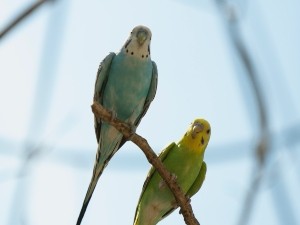
The cere of a healthy budgie is flat, if the bird is male, or slightly curved, if the bird is female, ceres are also small and smooth, but ceres will sometimes change and grow.
This article is a look into why your budgie has an overgrown cere.
Table of Contents
Budgie cere overgrowth:
Your bird’s appearance can tell you a lot about your bird’s health so a change in appearance will understandably be worrying to you as a bird owner.
If the bird’s cere grows and starts to look like a horn then the bird has a form of cere hypertrophy (overgrowth). Here is why this happens:
Female budgie kept in breeding condition for months:
If your bird is a female then your bird may have a condition called cere hypertrophy.
Cere hypertrophy can be caused by a variety of things but only reproductively active female birds, not males, will develop this condition
Female birds who have lots of the female reproductive hormone estrogen in their bodies will develop this condition.
This is a serious condition because the overgrown cere can block your bird’s nostrils and this can cause breathing issues in your bird.
This usually happens when there is an imbalance of protein and vitamins in their diet and it also develops if the bird’s environment contains things that trigger the desire to breed.
What to do:
You’d need to make sure that you’re bird’s diet contains all the vitamins and minerals that the bird needs to stay healthy.
You’d also need to make sure that the bird’s environment does not have anything that may trigger the bird to want to reproduce as this will trigger the body to overproduce estrogen. Nesting spots can trigger your bird to want to breed.
Taking your bird to the vet, or better yet, taking your bird to an avian vet, is also recommended. Avian vets have specific knowledge about birds.
The vet can remove the excess cere themselves or will guide you on how to properly remove the bird’s excess cere.
This will usually involve using an oil that is not harmful or poisonous to your pet to soften the cere and then peeling it off
Don’t try to remove the cere without consulting with your vet as you can hurt your bird accidentally during this process.
Note: Removing the bird’s excess cere may be a stressful experience for the bird so if you do this try to keep the bird calm and relaxed as best you can.
Hypertopy caused by mites or tumors:
Another reason why your bird may have developed hypertrophy of the cere is because of mites or tumors.
What to do:
Taking your bird to the vet is also recommended in this case. The vet will remove the excess cere or walk you through how to do this.
The excess cere can be removed by using a softening cream on the cere and removing the excess.
Removal of the overgrowth will only temporarily fix the problem but the cere will continue to overgrow if the underlying issue is not treated
Permanently treating the underlying cause will keep overgrowths from happening in the future.
If you enjoyed this article then you may also be interested in other bird related articles. Here are some articles that you may be interested in: Budgie Cere Hypertrophy, Why Is My Budgie’s Beak Dry?, How To Tell If Birds Are Bonded To Each Other, How To Know If A Parrot Is Angry, Why Are My Bird’s Feathers Turning Grey?, Cockatiel Growth On Side Of Beak, Black Feather Fungus, Black Spots On Cockatiel Feathers, Conure Feathers Turning Black

